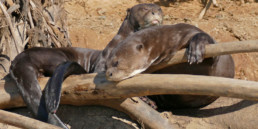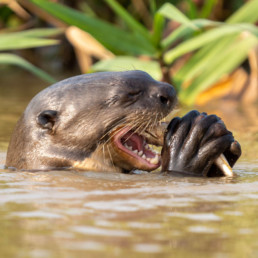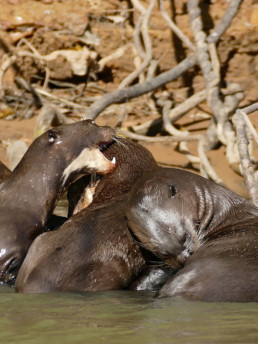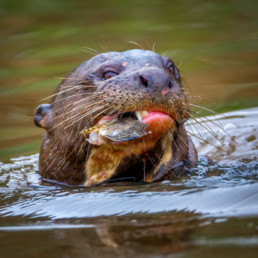Endangered
Vocal giant
The Giant Otter or Giant River Otter is a South American carnivorous mammal. It is the longest member of the weasel family, Mustelidae, a globally successful group of predators.
Giant Otters are up to 1.7 m long, with a long well-muscled tail. It is well adapted to life in the water having short, extremely dense fur that keeps water from penetrating to the skin. Its velvety texture has made it highly sought after by fur traders. It has sensitive whiskers which allow it to detect changes in water pressure and currents, helping it to track prey. Its legs are short and stubby and end in large, webbed feet tipped with sharp claws, and it can close its ears and nose while underwater.
The Giant Otter is a social species, with family groups typically supporting three to eight members. The groups are centered on a dominant breeding pair and are extremely cohesive and cooperative. Although generally peaceful, the species is territorial, and aggression has been observed between groups. The giant otter is diurnal, being active exclusively during daylight hours. It is the noisiest otter species, and distinct vocalizations have been documented that indicate alarm, aggression, and reassurance. The giant otter subsists almost exclusively on a diet of fish, but may also eat crabs, turtles, snakes, and small caimans. It has no serious natural predators other than humans.
Giant Otters build dens, which are holes dug into riverbanks, usually with multiple entrances and multiple chambers inside. They give birth within these dens during the dry season. This makes it easier for the adults to catch enough fish for the growing young, and for the pups to learn how to catch fish. The entire group, including nonreproductive adults, which are usually older siblings to that year’s pups, collaborates to catch enough fish for the young.
The Giant Otter prefers freshwater rivers and streams, which are usually seasonally flooded, and may also take to freshwater lakes and springs. It constructs extensive campsites close to feeding areas, clearing large amounts of vegetation. It is endemic to South America and is distributed east of the Andes in the Orinoco, Amazonas, and Parana basins, and the hydrographic networks of the Guianas.
Back from the brink
The animal faces a variety of critical threats. Poaching has long been a problem and the species was so thoroughly decimated in the Brazilian Amazon that by 1971 there were only 12 left. Poaching restrictions has helped the population recover. More recently, habitat destruction and degradation have become the principal dangers, and a further reduction of 50% is expected in giant otter numbers within the 25 years after 2020 (about the span of three generations of giant otters). Typically, loggers first move into rainforest, clearing the vegetation along riverbanks. Farmers follow, creating depleted soil and disrupted habitats. As human activity expands, giant otter home ranges become increasingly isolated. Other threats to the giant otter include conflict with fishermen, who often view the species as a nuisance.
Multiple ICF projects across South America contribute to the preservation of the Giant Otter.




